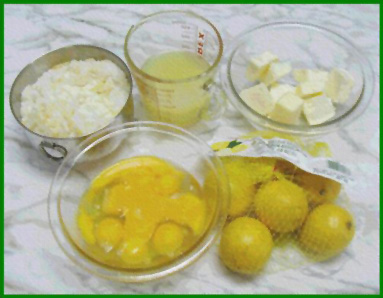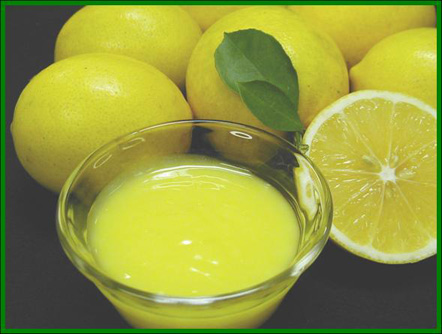
Canning techniques for specialty foods like fruit curds are currently highly requested by home-canners. In recommending a home-canning process to consumers, the issue of primary concern to the Extension educator is to ensure a microbiologically safe, high-quality shelf-stable product.
The objective was to experimentally calculate a boiling water thermal process and determine the effect of consumer procedural variation on heat penetration patterns of lemon curd.
A standardized lemon curd formulation (equilibrium pH 3.7) was hot-filled into half-pint home canning jars. The cold spot was determined with Ecklund Harrison copper-constantan thermocouples, inserted through lids, monitoring product temperatures at four potential cold spots in sixteen canner loads. Sealed jars were placed in the canner and temperatures recorded using EllabTM software, through come-up, cool down, and a processing time that heated all jars to a minimum of 2°C below canner temperature. Analyses of f(h) values (slope of the straight line portion of a heating curve) located the cold spot at the geometric center of the jar. Cold-spot temperatures were then monitored through confirmation canning processes that produced a minimum final temperature of 90.5°C, for both standard filling and low-initial temperature filling variations. f(h) values were used to calculate the effect of consumer-induced procedural changes on the thermal process.
A boiling water process recommendation of 15 min was calculated for this product. Up to a 15 minute post-cook delay prior to filling jars did not significantly change f(h) values when compared with the standard treatments.
Confidence in science-based thermal processing recommendations is essential for novel home-canned food products that are similar to commercially available high-demand items. A 15 minute boiling water heat process for this lemon curd ensures a safe, shelf-stable product. This study produced a research-based home-canning recommendation for a highly sought-after, distinct product category.
Expanding food markets catering to eclectic tastes have made available a plethora of specialty food products, encompassing new forms of local foods, as well as various ethnic and international items. Lemon curd, a mixture of eggs, butter, lemon juice and sugar that results in a tart, sauce-like product is much coveted by epicures worldwide. Numerous and persistent requests for a safe USDA-recommended home-canning process for this category of foods prompted this research (Andress, 2001).
The objective of this project was to develop a high-quality product, determine an adequate thermal process for home-canned lemon curd, and to study the effect of consumer procedural variation on the thermal process. Since this is an acid product, the primary concern was to ensure the development of a safe, standardized product, to prevent spoilage from acid-resistant microorganisms during storage, and to recommend a shelf-life for the developed lemon curd.
Lemon Curd:
Ingredients: 2½ cups superfine sugar*, ½ cup lemon zest (freshly zested), optional, 1 cup bottled lemon juice**,
¾ cup unsalted butter, chilled, cut into approximately ¾" pieces, 7 large egg yolks, 4 large whole eggs
Yield: About 3-4 half-pint jars.
* If superfine sugar is not available, run granulated sugar through a grinder or food processor for 1 minute, let settle, and use in place of superfine sugar. Do not use powdered sugar.
** Bottled lemon juice is used to standardize acidity. Fresh lemon juice can vary in acidity and is not recommended.

Procedure:
Shelf- life: For best quality, store in a cool, dark place, away from light. Use canned lemon curd within 3 -4 months. Browning and/or separation may occur with longer storage; discard any time these changes are observed.
Variation: For Lime Curd, use the same recipe but substitute 1 cup bottled lime juice and ¼ cup fresh lime zest for the lemon juice and zest.
Determination of the cold spot for this product and jar combination was made using data collected for heat penetration curves at 4 potential cold spot locations in the jars in 16 canner loads (see Table 1).
Procedural variation based on a pre-fill lag time was used in testing for process calculations. Temperature profiles were compared for fill temperatures (direct-fill, and after a 15 minute wait), which had means of 55.80° and 46.66°C, respectively. Process calculation was accomplished by using thermocouples in each of six jars in different canner loads of each of the two fill methods (standard, and low initial temperature). These jars were processed to 90.5°C plus an additional 5 minutes.
Processing was done in a boiling water canner using the stovetop burners of a household gas range (Frigidaire Gallery Model ES III). Data was recorded using an Ellab E-ValTM Monitoring System and Software, and Ecklund needle Type T copper-constantan thermocouples. Analysis of variance was used to determine if significant (p<.001) differences existed between the treatments using the General Linear Model procedure in SAS 9.1 (2002-2003).
Table 2: Thermal Characteristics of Jars Processed by Two Methods
| Procedures | ||
| Standard | Low Fill Temperature | |
| n=12 | n=24 | |
| Total Fill Weight | 235.2 g (mean) | 237.7 g (mean) |
| °C | °C | |
| Canner Initial Temperature | 81.33 ± 1.38 | 81.77 ± 0.44 |
| Jar Initial Temperature¹ | 55.74 ± 0.73 | 46.66 ± 0.62 |
| Jar Temperature at Start of Boiling | 68.85 ± 1.93 | 67.60 ± 2.97 |
| Mean temperature change during come-up time | +13.11 | +20.94 |
| Jar Temperature at the end of experimental process² | 92.93 ± 0.44 | 92.73 ± 0.70 |
| Maximum temperature change during process | + 37.19 | + 46.07 |
| ¹Heat penetration data for 6 jars each were collected from different canner loads | ||
| ²Heat penetration data were collected by allowing the slowest-heating jar to reach 90.5°C plus an additional 5 minutes heating time | ||

 in minutes, based on product pH. Since the equilibrium pH of the lemon curd product is 3.7, according to process development guidelines a minimum
in minutes, based on product pH. Since the equilibrium pH of the lemon curd product is 3.7, according to process development guidelines a minimum  of 0.1 minutes is enough to ensure an appropriately canned product.
of 0.1 minutes is enough to ensure an appropriately canned product. of 0.1 minutes for the lemon curd is achieved within 10-11 minutes from the start of process time (i.e. 10-11 minutes after come–up time).
of 0.1 minutes for the lemon curd is achieved within 10-11 minutes from the start of process time (i.e. 10-11 minutes after come–up time). of 0.1 minutes to be reached, regardless of f(h). Hence, it is essential for this particular process, to specify in process instructions, that the initial canner temperature should be 82°C. This allows the requisite come-up time to be achieved, and the accompanying
of 0.1 minutes to be reached, regardless of f(h). Hence, it is essential for this particular process, to specify in process instructions, that the initial canner temperature should be 82°C. This allows the requisite come-up time to be achieved, and the accompanying  of 0.1 minutes to be achieved well within the recommended process time for this product.
of 0.1 minutes to be achieved well within the recommended process time for this product.| Style of Pack | Hot | ||
| Jar Size | Half-pints | ||
| Altitude | 0-1,000 ft | 1,001-6,000 ft | Above 6,000 ft |
| Processing Time | 15 min | 20 min | 25 min |
Effect of Fill Weight and Initial Jar Temperature
Table 4: Effect of Fill Temperature on Heat Penetration of Lemon Curd in Half-pint Jars
| Procedures | ||
| Standard | Low Fill Temperature | |
| n=12 | n=24 | |
| Total Fill Weight | 235 g | 237 g |
| Jar Initial Temperature (°C) | 55.74 ± 0.73 | 46.66 ± 0.62 |
| Mean f(h) | 42.35 ± 1.83 | 42.76 ± 1.71 |
| Average Minutes to Reach 90.5°C at boiling¹ | 26.41 ± 1.24 | 25.87 ± 2.45 |
| ¹Time after water in canner returned to boiling. This comparison of averages is for statistical purposes; in practice, the process time would be determined by the slowest heating individual jar (Garner, 2002). | ||
| 1. | Andress, E.L. 2001. A national survey of current home canning practices in the U.S. Athens, GA: National Center for Home Food Preservation, Department of Foods and Nutrition, The University of Georgia. Unpublished data. | |
| 2. | Garner, H. H. and Andress, E.L. 2002. Effect of fill weight and initial temperature on processing time for a home pickled jicama relish. Poster presented at IFT Annual Meeting, Anaheim, CA. |
|
| 3. | Pflug, I. J. 1998. Microbial Control Processes
 for Acid Foods. In Microbiology and Engineering Processes. Environmental Sterilization Laboratory, Minneapolis, MN for Acid Foods. In Microbiology and Engineering Processes. Environmental Sterilization Laboratory, Minneapolis, MN
|
|
| 4. | Statistical Analysis Software, SAS 9.1, 2002-2003. Cary, NC: SAS Institute Inc.
|
This project was partially funded through a grant from the National Integrated food Safety Initiative (Grant No. 00-51110-9762) of the Cooperative State Research, Education, and Extension Service, U.S. Department of Agriculture.
Document Use:
Permission is granted to reproduce these materials in whole or in part for educational purposes only (not for profit beyond the cost of reproduction) provided the authors and the University of Georgia receive acknowledgment and this notice is included:
Reprinted with permission of the University of Georgia. E. M. D’Sa, E. L. Andress, J. A. Harrison and M. A. Harrison. 2006. Thermal Process Development to Ensure the Safety of a Home-Canned Lemon Curd Product. Athens, GA: The University of Georgia, Cooperative Extension Service.
References to commercials products, services, and information is made with the understanding that no discrimination is intended and no endorsement by the University of Georgia, U.S. Department of Agriculture and supporting organizations is implied. This information is provided for the educational information and convenience of the reader.
The University of Georgia and Ft. Valley State University, the U.S. Department of Agriculture and counties of the state cooperating. The Cooperative Extension Service, the University of Georgia College of Agricultural and Environmental Sciences offers educational programs, assistance and materials to all people without regard to race, color, national origin, age, sex or disability. An Equal Opportunity Employer/Affirmative Action Organization Committed to a Diverse Work Force.
Contact: